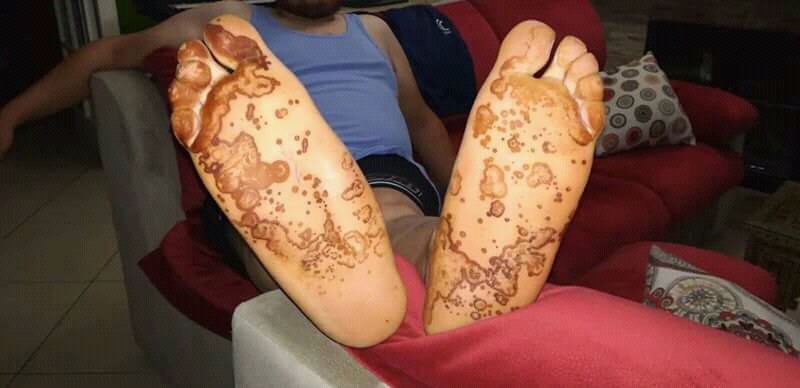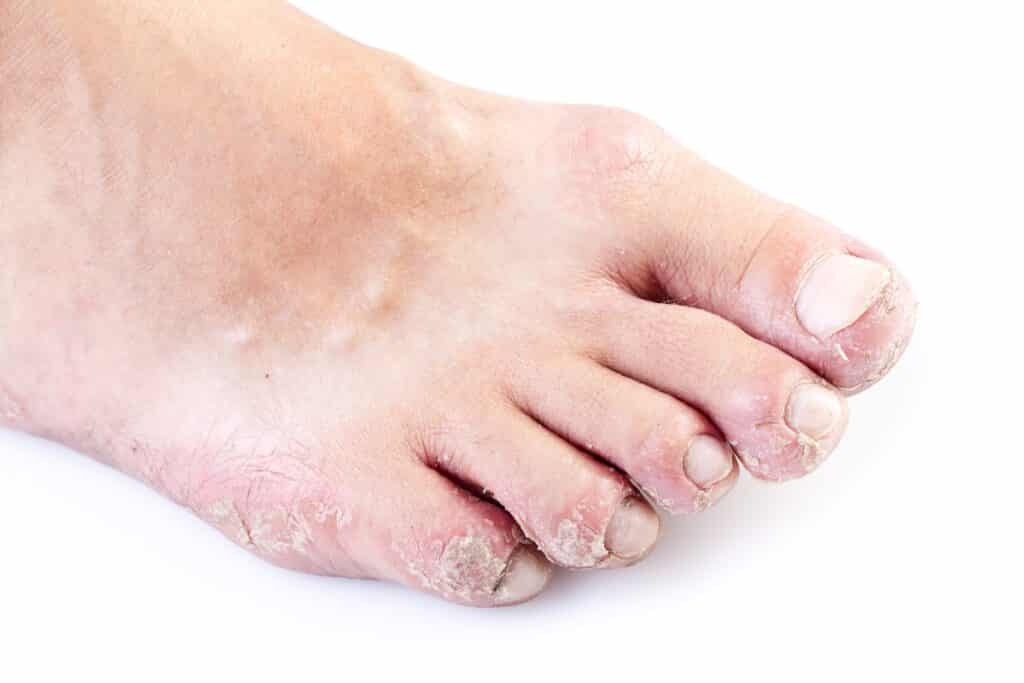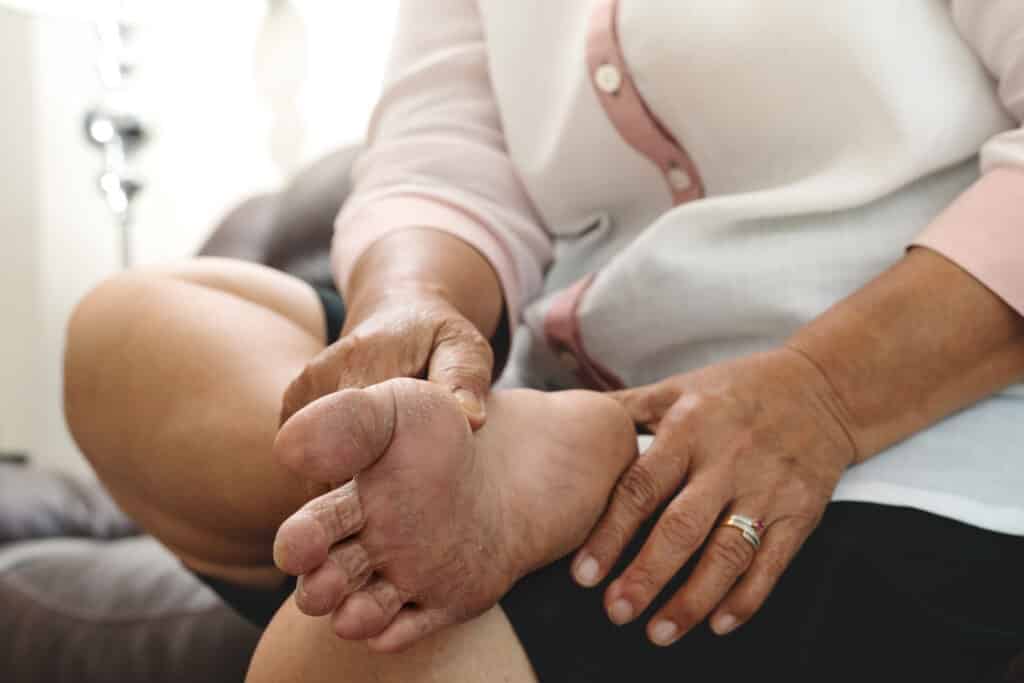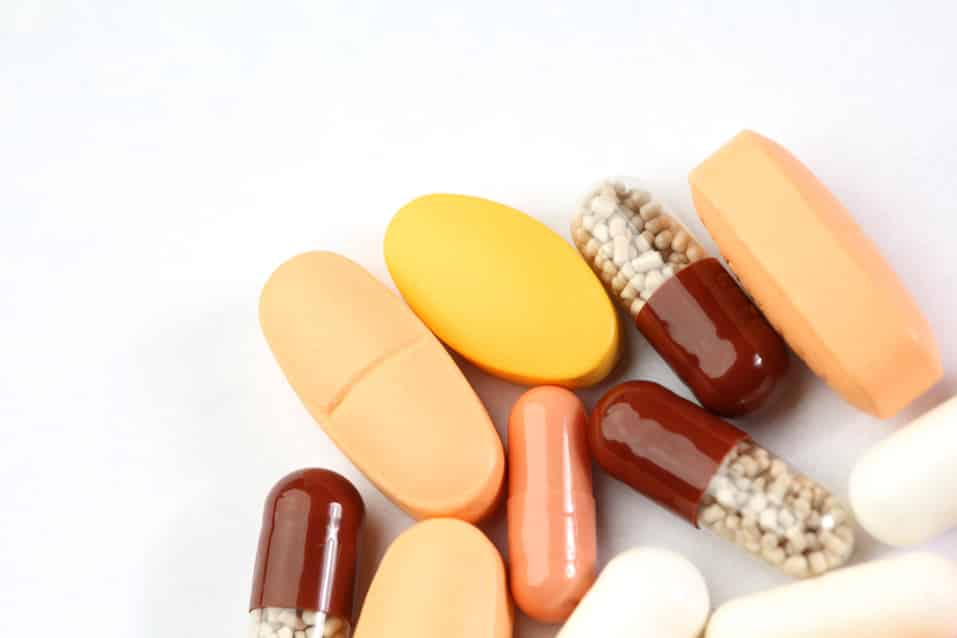What is Palmoplantar Keratoderma?
In keratoderma, the outer layer of the skin thickens abnormally.
When it affects the palms and soles, it’s called palmoplantar keratoderma (PPK), or “keratosis palmaris et plantaris.”
But palmar-plantar keratoderma isn’t a single disease. Different health issues, both inherited and acquired, can cause it.1Cristina Has, Kristin Technau-Hafsi
. Palmoplantar keratodermas: clinical and genetic aspects
, J Dtsch Dermatol Ges
. 2016
Hereditary palmoplantar keratoma includes:
- Diffuse PPK, which affects most of the palm and sole surface. The surface thickens, covered with a yellowish, waxy substance. 2Tomo Sakiyama, Akiharu Kubo
. Hereditary palmoplantar keratoderma “clinical and genetic differential diagnosis.”
, J Dermatol
. 2016 - Focal and striate, which PPK affects pressure and friction points. These areas look like calluses and can become infected.
- Punctate-type PPK which causes multiple small bumps or spikes with healthy skin in-between.
Acquired keratodermas appear later in life. They’re classified based on what caused them – infections, inflammatory conditions, cancers, toxins, etc.
What Causes Keratoderma?
The outer layer of your skin, the epidermis, is made up of several layers.
New skin cells are born in the basal layer, and they move up, flattening, and filling up with keratin.

The final layer contains 15-20 layers of keratin-filled cells, a barrier against dehydration, injury, and bacteria.
Keratin is a protein made up of interlaced fibers.
It’s one of the toughest biological materials, protecting your organs from trauma and infection. In keratodermas, the skin thickens because its keratin has changed, or your skin produces it in excess.3Bin Wang, Wen Yang, Joanna McKittrick, Marc André Meyers. Keratin: Structure, mechanical properties, occurrence in biological organisms, and efforts at bioinspiration
, Progress in Materials Science. 2016
Since your soles are under more mechanical stress than any other part of your body, their keratin layer is thicker.
That is why keratodermas affect the soles and palms more than any other part of the body.
Hereditary Palmar-Plantar Keratoderma
These conditions run in families, either in every generation (autosomal dominant) or less often (autosomal recessive). Parents pass down a defective keratin gene to their children.
The PPK might affect internal organs, that’s why your doctor might recommend a full-body exam.
Inherited PPK appears early in life – childhood or adolescence, but it could get worse with time.4H L FRED, R G GIESER, W R BERRY, J M EIBAND. KERATOSIS PALMARIS ET PLANTARIS
, Arch Intern Med
. 1964
Acquired Palmar-Plantar Keratoderma
In these diseases, the skin change isn’t passed down through a faulty gene. Instead, it’s the result of another health issue like:
- Skin inflammation like eczema or psoriasis.
- Infections like athlete’s foot (a fungal infestation).
- Circulation problems like lymphoedema (damage or block in the lymph drainage of your feet.)
- Medications and toxins like lithium (for bipolar disorder), iodine, and cancer therapy.
- Internal disease like an underactive thyroid gland or cancer.
When psoriasis affects the feet, the condition is called palmoplantar psoriasis.
It can cause small, pus-filled blisters on your feet and vast areas of inflamed skin.
Psoriasis is an autoimmune condition, meaning your immune system attacks the skin.

Stress, alcohol, and some medications can all make psoriasis flare-ups worse.5Adriana Rendon and Knut Schäkel. Psoriasis Pathogenesis and Treatment
, Int J Mol Sci. 2019
Is Palmoplantar Keratoderma Contagious?
No, PPK isn’t contagious, but some of its causes are. For instance, athlete’s foot is a fungal infection of the feet and toes.
Avoid contracting it, don’t share towels, and avoid walking barefoot in humid areas, where fungi thrive.
Signs & Symptoms
The skin thickening in palmoplantar keratoma varies, depending on the type of disease.

It can range from smooth and waxy to rough and scaly. Skin cracks might appear, becoming painful and inflamed.
Since you usually sweat more in the thickened areas, you might notice a constant foul smell.
Is Palmoplantar Keratoderma Curable?
You can’t cure hereditary PPK, but you can alleviate the symptoms. With acquired palmoplantar keratoderma, treating the underlying problem can heal the skin condition.
Palmoplantar Keratoderma Treatment
If you suffer from plantar keratoderma, a consistent foot care routine is a must. Not only does it reduce pain and discomfort, but it also prevents dangerous fungal and bacterial infections. 6Meliha Skaljic. <a href=”https://emedicine.medscape.com/article/1108406-overview” target=”_blank”>Keratosis Palmaris et Plantaris,</a> Medscape. 2019
Skincare options include:
- Debulk with a callus remover.
- Chemically exfoliate with keratolytic agents like salicylic acid.
- Moisturize often.
- Use products with vitamin A (retinoids) and vitamin D (for palmoplantar psoriasis)

It’s crucial to maintain foot hygiene because palmar-plantar keratosis makes you susceptible to infections:
- Thoroughly clean your feet with mild soap (to avoid skin irritation.)
- Wear clean socks, changing them daily.
- Make sure the insides of your shoes are clean and rotate pairs (avoid wearing the same shoes several days on a row.)
- For working out, choose breathable socks and shoes. They move moisture away from your feet and prevent infections like athlete’s foot.
- Avoid walking barefoot, especially in public areas.
Your doctor can recommend other therapies like UV light, oral treatment, or biological agents.7Inês Raposo, Tiago Torres. Palmoplantar Psoriasis and Palmoplantar Pustulosis: Current Treatment and Future Prospects, American Journal of Clinical Dermatology. 2016

If traditional treatment isn’t working for you, homeopathic therapies are another option to explore. Medications that have been effective in psoriasis patients include Lycopodium, Tuberculinum, Sulphur, and Staphysagria. To prevent the problem from resurfacing, you might need maintenance therapy as well.8Alyssa Miceli; George J. Schmieder.. Palmoplantar Psoriasis
, StatPearls Publishing; 2020
Palmoplantar psoriasis is usually worse in smokers, so it’s also a good idea to quit smoking.9A M G Brunasso, M Puntoni, W Aberer, C Delfino, L Fancelli, C Massone
. Clinical and epidemiological comparison of patients affected by palmoplantar plaque psoriasis and palmoplantar pustulosis: a case series study
, Br J Dermatol
. 2013 10H A Miot, L D B Miot, P S Lopes, G R Haddad, S A Marque. Association Between Palmoplantar Pustulosis and Cigarette Smoking in Brazil: A Case-Control Study, Journal of the European Academy of Dermatology and Venereology. 2009
Palmoplantar Keratosis: Final Thoughts
Skin thickening can be uncomfortable, painful, and it could lead to infections. But, with the right foot care, you can alleviate the symptoms and prevent complications.
Have you struggled with palmoplantar keratoderma? What are your best tips for managing it? Let us know in the comments below!
